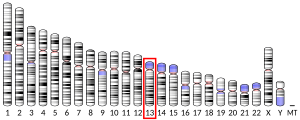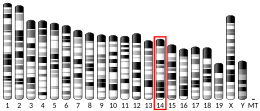CENPJ
Centromere protein J is a protein that in humans is encoded by the CENPJ gene.[5][6] It is also known as centrosomal P4.1-associated protein (CPAP). During cell division, this protein plays a structural role in the maintenance of centrosome integrity and normal spindle morphology, and it is involved in microtubule disassembly at the centrosome. This protein can function as a transcriptional coactivator in the Stat5 signaling pathway and also as a coactivator of NF-kappaB-mediated transcription, likely via its interaction with the coactivator p300/CREB-binding protein.
The Drosophila ortholog, sas-4, has been shown to be a scaffold for a cytoplasmic complex of Cnn, Asl, CP-190, tubulin and D-PLP (similar to the human proteins PCNT and AKAP9). These complexes are then anchored at the centriole to begin formation of the centrosome.[7]
Clinical significance
[edit]Mutations in CENPJ are associated with Seckel syndrome type 4 and primary autosomal recessive microcephaly, a disorder characterized by severely reduced brain size and intellectual disability.[6][8][9] Interestingly, CENPJ interacts with other microcephaly aossciated proteins such as WDR62 and both coordinate a regulatory function neocortical development and brain growth. [10]
Interactions
[edit]CENPJ has been shown to interact with EPB41.[5]
See also
[edit]References
[edit]- ^ a b c GRCh38: Ensembl release 89: ENSG00000151849 – Ensembl, May 2017
- ^ a b c GRCm38: Ensembl release 89: ENSMUSG00000064128 – Ensembl, May 2017
- ^ "Human PubMed Reference:". National Center for Biotechnology Information, U.S. National Library of Medicine.
- ^ "Mouse PubMed Reference:". National Center for Biotechnology Information, U.S. National Library of Medicine.
- ^ a b Hung LY, Tang CJ, Tang TK (Oct 2000). "Protein 4.1 R-135 interacts with a novel centrosomal protein (CPAP) which is associated with the gamma-tubulin complex". Molecular and Cellular Biology. 20 (20): 7813–25. doi:10.1128/MCB.20.20.7813-7825.2000. PMC 86375. PMID 11003675.
- ^ a b "Entrez Gene: CENPJ centromere protein J".
- ^ Gopalakrishnan J, Mennella V, Blachon S, Zhai B, Smith AH, Megraw TL, Nicastro D, Gygi SP, Agard DA, Avidor-Reiss T (2011). "Sas-4 provides a scaffold for cytoplasmic complexes and tethers them in a centrosome". Nature Communications. 2: 359. Bibcode:2011NatCo...2..359G. doi:10.1038/ncomms1367. PMC 3677532. PMID 21694707.
- ^ Al-Dosari MS, Shaheen R, Colak D, Alkuraya FS (Jun 2010). "Novel CENPJ mutation causes Seckel syndrome". Journal of Medical Genetics. 47 (6): 411–4. doi:10.1136/jmg.2009.076646. PMID 20522431. S2CID 35159613.
- ^ Gul A, Hassan MJ, Hussain S, Raza SI, Chishti MS, Ahmad W (2006). "A novel deletion mutation in CENPJ gene in a Pakistani family with autosomal recessive primary microcephaly". Journal of Human Genetics. 51 (9): 760–4. doi:10.1007/s10038-006-0017-1. PMID 16900296.
- ^ Shohayeb, B, et al. (January 2020). "The association of microcephaly protein WDR62 with CPAP/IFT88 is required for cilia formation and neocortical development". Human Molecular Genetics. 29 (2): 248–263. doi:10.1093/hmg/ddz281. PMID 31816041.
Further reading
[edit]- Bonaldo MF, Lennon G, Soares MB (Sep 1996). "Normalization and subtraction: two approaches to facilitate gene discovery". Genome Research. 6 (9): 791–806. doi:10.1101/gr.6.9.791. PMID 8889548.
- Iouzalen N, Andreae S, Hannier S, Triebel F (Oct 2001). "LAP, a lymphocyte activation gene-3 (LAG-3)-associated protein that binds to a repeated EP motif in the intracellular region of LAG-3, may participate in the down-regulation of the CD3/TCR activation pathway". European Journal of Immunology. 31 (10): 2885–91. doi:10.1002/1521-4141(2001010)31:10<2885::AID-IMMU2885>3.0.CO;2-2. PMID 11592063. S2CID 26417417.
- Tchernev VT, Mansfield TA, Giot L, Kumar AM, Nandabalan K, Li Y, Mishra VS, Detter JC, Rothberg JM, Wallace MR, Southwick FS, Kingsmore SF (Jan 2002). "The Chediak-Higashi protein interacts with SNARE complex and signal transduction proteins". Molecular Medicine. 8 (1): 56–64. doi:10.1007/BF03402003. PMC 2039936. PMID 11984006.
- Peng B, Sutherland KD, Sum EY, Olayioye M, Wittlin S, Tang TK, Lindeman GJ, Visvader JE (Sep 2002). "CPAP is a novel stat5-interacting cofactor that augments stat5-mediated transcriptional activity". Molecular Endocrinology. 16 (9): 2019–33. doi:10.1210/me.2002-0108. PMID 12198240.
- Leal GF, Roberts E, Silva EO, Costa SM, Hampshire DJ, Woods CG (Jul 2003). "A novel locus for autosomal recessive primary microcephaly (MCPH6) maps to 13q12.2". Journal of Medical Genetics. 40 (7): 540–2. doi:10.1136/jmg.40.7.540. PMC 1735531. PMID 12843329.
- Hung LY, Chen HL, Chang CW, Li BR, Tang TK (Jun 2004). "Identification of a novel microtubule-destabilizing motif in CPAP that binds to tubulin heterodimers and inhibits microtubule assembly". Molecular Biology of the Cell. 15 (6): 2697–706. doi:10.1091/mbc.E04-02-0121. PMC 420094. PMID 15047868.
- Koyanagi M, Hijikata M, Watashi K, Masui O, Shimotohno K (Apr 2005). "Centrosomal P4.1-associated protein is a new member of transcriptional coactivators for nuclear factor-kappaB". The Journal of Biological Chemistry. 280 (13): 12430–7. doi:10.1074/jbc.M410420200. PMID 15687488.
- Bond J, Roberts E, Springell K, Lizarraga SB, Lizarraga S, Scott S, Higgins J, Hampshire DJ, Morrison EE, Leal GF, Silva EO, Costa SM, Baralle D, Raponi M, Karbani G, Rashid Y, Jafri H, Bennett C, Corry P, Walsh CA, Woods CG (Apr 2005). "A centrosomal mechanism involving CDK5RAP2 and CENPJ controls brain size". Nature Genetics. 37 (4): 353–5. doi:10.1038/ng1539. PMID 15793586. S2CID 1763877.
- Cho JH, Chang CJ, Chen CY, Tang TK (Jan 2006). "Depletion of CPAP by RNAi disrupts centrosome integrity and induces multipolar spindles". Biochemical and Biophysical Research Communications. 339 (3): 742–7. doi:10.1016/j.bbrc.2005.11.074. PMID 16316625.
- Kimura K, Wakamatsu A, Suzuki Y, Ota T, Nishikawa T, Yamashita R, Yamamoto J, Sekine M, Tsuritani K, Wakaguri H, Ishii S, Sugiyama T, Saito K, Isono Y, Irie R, Kushida N, Yoneyama T, Otsuka R, Kanda K, Yokoi T, Kondo H, Wagatsuma M, Murakawa K, Ishida S, Ishibashi T, Takahashi-Fujii A, Tanase T, Nagai K, Kikuchi H, Nakai K, Isogai T, Sugano S (Jan 2006). "Diversification of transcriptional modulation: large-scale identification and characterization of putative alternative promoters of human genes". Genome Research. 16 (1): 55–65. doi:10.1101/gr.4039406. PMC 1356129. PMID 16344560.
- Chen CY, Olayioye MA, Lindeman GJ, Tang TK (Apr 2006). "CPAP interacts with 14-3-3 in a cell cycle-dependent manner". Biochemical and Biophysical Research Communications. 342 (4): 1203–10. doi:10.1016/j.bbrc.2006.02.089. PMID 16516142.
- Evans PD, Vallender EJ, Lahn BT (Jun 2006). "Molecular evolution of the brain size regulator genes CDK5RAP2 and CENPJ". Gene. 375: 75–9. doi:10.1016/j.gene.2006.02.019. PMID 16631324.
- Lim J, Hao T, Shaw C, Patel AJ, Szabó G, Rual JF, Fisk CJ, Li N, Smolyar A, Hill DE, Barabási AL, Vidal M, Zoghbi HY (May 2006). "A protein-protein interaction network for human inherited ataxias and disorders of Purkinje cell degeneration". Cell. 125 (4): 801–14. doi:10.1016/j.cell.2006.03.032. PMID 16713569. S2CID 13709685.







